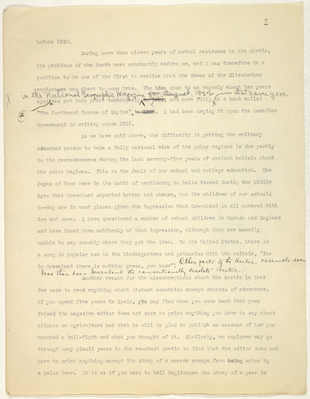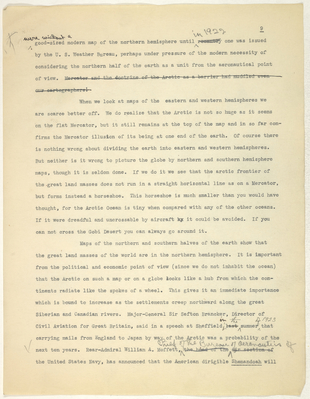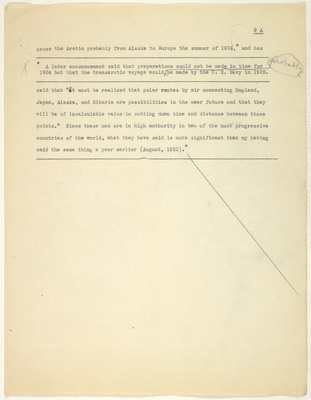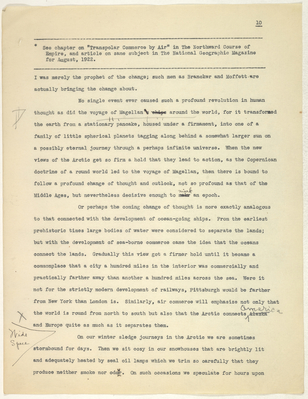Pages
stefansson-wrangel-09-26-001-011
before 1930.
During more than eleven years of actual residence in the Arctic, the problems of the North were constantly before me, and I was therefore in a position to be one of the first to realize that the dream of the Elizabethan navigators was about to come true. The idea came to me vaguely about ten years ago; In the National Geographic Magazine for August 1922 was put into print tentatively and more fully that same year in a book called "The Northward Course of Empire." I had been urging it upon the Canadian Government in writing since 1918.
As we have said above, the difficulty in getting the ordinary educated person to take a fully rational view of the polar regions is due partly to the recrudescence during the last seventy-fice years of ancient beliefs about the polar regions. This is the fault of our school and college education. The Popes of Rome were in the habit of mentioning in bulls issued during the Middle Ages that Greenland exported butter and cheese, but the children of our schools to-day are in most places given the impression that Greenland is all covered with ice and snow. I have questioned a number of school children in Canada and England and have found them uniformly of that impression, although they are usually unable to say exactly whre they got the idea. In the United States, there is a song in popular use in the kindergartens and primaries with the refrain, "For in Greenland there is nothing green, you know": Other parts of the Arctic resemble less than does Greenland the conventionally desolate Arctic.
Another reason for the misconceptions about the Arctic is that few care to read anything about distant countries except stories of adventure. If you spend five years in Spain, you may find when you come back that your friend the magazine editor does not care to print anything you have to say about climate or agriculture but that he will be glad to publish an account of how you watched a bull-fight and what you thought of it. Similarly, an explorer may go through many placid years in the remotest Arctic to find that the editor does not care to print anything except the story of a narrow escape from being eating by a polar bear. It is as if you were to tell Englishmen the story of a year in
stefansson-wrangel-09-26-001-012
8 Chicago wholly in terms of the Stockyards, motor accidents and deaths from sunstroke.
Probably the most insidious and effective opponent of a rational view of the earth is Mercator with his grotesque chart. The earth is flat in the idiom of our speech, it is flat when you look out through your window, and it is flat when you glance at a wall where hangs a map with Greenland looking bigger than South America and with the north coasts of Alaska, Canada and Siberia stretching horizontally from east to west. It is simple and natural to consider the earth as flat. The sailor knows how simple it is in theory to cross the ocen on the presumption of flatness, but he knows also that nobody but a fool would do it. Hence that pictureesque expression "plane sailing" which ? describes a thing so easy that any fool can do it.
The navigators are among the few people who have to apply day by day their knowledge that the earth is round. Most of the rest of us, including politicians, are under no such compulsion. We speak of the "top" of the earth, and we have on our wall Mercator's chart with Canada and Siberia at the top. We see the arctic islands lying between continents on one side and the ceiling on the other, and we ge the idea that they lie between Canada and Siberia on one side and infinity or nothingness on the other. This misleading presentation has actually led to the half-formulation of a doctrine of international law to the effect that one land belongs to another because of lying to the north. That would be logical if the earth were flat and had a farther edge. It looks logical on Mercator's chart, but the logic wholly disappears when you consider the map of the northern hemisphere. Such maps are rare. In the summer of1923, I visited every well-known shop in London and was unable to buy a map of the northern hemisphere except on a small and practically diagrammatic scale as a sort of footnote to a map of the eastern and western hemispheres. Even the firstmap collections in the United states
stefansson-wrangel-09-26-001-013
were without a good-sized modern map of the northern hemisphere until in 1922 one was issued by the U.S. Weather Bureau, perhaps under pressure of the modern necessity of considering the northern half of the earth as a unit from the aeronautical point of view. Mercater and the doctrine of the Arctic as a barrier had muddled even our cartographers!
When we look at maps of the eastern and western hemispheres we are scarce better off. We do realize that the Arctic is not so huge as it seems on the flat Mercator, but it still remains at the top of the map and in so far confirms the Mercator illusion of its being at one end of the earth. Of course there is nothing wrong about dividing the earth into eastern and western hemisphere maps, thought it is seldom done. If we do it we see that the arctic frontier of the great land masses does not run in a straight horizontal line as on a Mercator, but forms instead a horseshoe. This horseshoe is much smaller than you would have thought, for the Arctic Ocean is tiny when compares with any of the other oceans. If it were dreadful and uncrossable by aircraft it could be avoided. if you can not cross the Gobi Desert you can always go around it.
Maps of the northern and southern halves of the earth show that the great land masses of the world are in the northern hemisphere. It is important from the political and economic point of view (since we do not inhabit the ocean) that the Arctic on such a map or on a globe looks like a hub from which the continents radiate like the spokes of a wheel. This gives it an immediate importance which is bound to increase as the settlements creep northward along the great Siberian and Canadian rivers. Major-General Sir Sefton Brancker, Director of Civil Aviation for Great Britain, said in a speech at Sheffield in thesummerof 1923 that carrying mails from England to Japan by way of the Arctic was a probability of the next ten years. Rear-Admiral William A. Moffett, Chief of the Burear of Aeronautics the Unites States Navy, has announced that the American dirigible Shenandoah will
stefansson-wrangel-09-26-001-014
9 A
cross the Arctic probably from Alaska to Europe the summer of 1924,* and has
-------------------------------------------------------------------------------------------------------------- *A later announcement said that preparations could not be madg in time for 1924 but that the transarctic voyage would probably be made by the U.S. Navy in 1925. --------------------------------------------------------------------------------------------------------------
said that "it must be realized that polar routes by air connecting England, Japan, Alaska, and Siberia are possibilities in the near future and that they will be of incalculable value in cutting down time and distance between those points." Since these men are in high authority in two of the most progressive countries of the world, what they have said is more significant than my having said the same thing a year earlier (August, 1922). *
stefansson-wrangel-09-26-001-015
10
* See chapter on "Transpolar Commerce by Air" in The Northward Course of Empire, and article on same subject in The National Geographic Magazine for August, 1922.
I was merely the prophet of the change; such men as Brancker and Moffett-are actually bringing the change about.
No single event ever caused such a profound revolution in human thought as did the voyage of Magellan around the world, for it transformed the earth from a stationary pancake, housed under a firmament, into one of a family of little spherical planets tagging along behind a somewhat larger sun on a possibly eternal journey through a perhaps infinite universe. When the new views of the Arctic get so firm a hold that they lead to action, as the Copernican doctrine of a round world led to the voyage of Magellan, then there is bound to follow a profound change of thought and outlook, not so profound as that of the Middle Ages, but nevertheless decisive enough to make markan epoch.
Or perhaps the coming change of thought is more exactly analogous to that connected with the development of ocean-going ships. From the earliest prehistoric times large bodies of water were considered to separate the lands; but with the development of sea-borne commerce came the idea that the oceans connect the lands. Gradually this view got a firmer hold until it became a commonplace that a city a hundred miles in the interior was commercially and practically farther away than another a hundred miles across the sea. Were it not for the strictly modern development of railways, Pittsburgh would be farther from New York than London is. Similarly, air commerce will emphasize not only that the world is round from north to south but also that the Arctic connects AmericaAmerica and Europe quite as much as it separates them.
Wide SpaceOn our winter sledge journeys in the Arctic we are sometimes stormbound for days. Then we sit cosy in our snowhouses that are brightly lit and adequately heated by seal oil lamps which we trim so carefully that they produce neither smoke nor odor. On such occasions we speculate for hours upon




